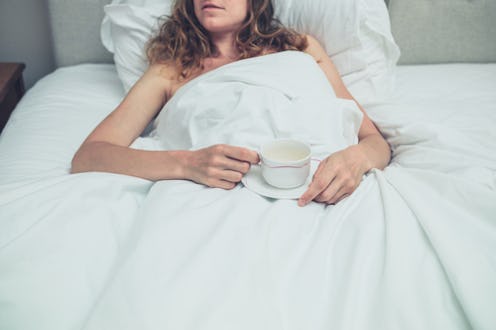
You might be trying to limit how much you buy single-use plastics out of concern for pollution accumulating in Earth's landfills and oceans. And that's definitely important, because plastic production and pollution is a substantial threat to atmospheric carbon dioxide levels, according to the Center for International Environmental Law. But now, a new study is suggesting that you also might want to worry about how much plastic is in your own bloodstream. Apparently, tea bags may release plastic particles into your morning cuppa and into your body.
The study, published in the journal Environmental Science and Technology, set out to determine what happens when tea bags containing plastic sealants are used to brew your favorite morning beverage. It turns out that a single tea bag, when brewed at a typical 95 degrees, releases large doses of micro- and nano-plastics, aka very, very tiny plastic particles.
Just one tea bag with this sealant brewed in a single cup of hot water releases 11.6 billion microplastic and 3.1 billion nanoplastic particles, according to the study. And this wasn't from any kind of contamination from tea or any excess particles that might have somehow gotten onto the bag: before conducting the experiment, the researchers emptied the tea bags of their tea and washed the bags thoroughly. That way, their measurements of plastic levels in water after brewing would be only focused on what came from the plastic tea bag itself.
But why does your tea bag even contain plastic to begin with, you might ask? The polypropylene sealant used across the industry to help tea bags keep their shape is what breaks down to form all these microplastic particles. And while not all tea brands use this plastic sealant, chances are that your morning brew might just contain these leeched microplastic particles.
Can you be sure that these tiny, tiny particles actually impact your body, though? To address this question, researchers didn't stop at just measuring levels of plastic particles. Enter Daphnia magna, otherwise known as water fleas. These tiny crustaceans live all around the world, inhabiting standing freshwater in most environments. In this plastic study, the researchers used water fleas as a proxy for mammal-based research to help determine what, if any, health ramifications exist because of the abundance of micro- and nanoplastic particles in your tea. The water fleas survived being dosed with these plastic particles, but they also displayed behavioral and developmental changes based on the plastic particle dose they were subjected to.
And while the water fleas' responses are not necessarily directly predictive of human responses, researchers have long been eager to study the correlations between water flea responses to toxins and assessing potential dangers to humans, according to a February 2011 article in Nature. Given that water fleas' adverse bodily and behavioral responses got worse with higher doses of plastic particles, the study suggested that there might be implications for human health.
This is perhaps unsurprising, given that a 2019 study published in the journal Marine Pollution Bulletin found that heightened levels of microplastics in ocean water increases risk of human bacterial infection and toxic chemical exposure. And another 2019 study published in the journal Water Research found that frequent drinking from single-use bottled water increases the risk of human exposure to plastic microparticles. This exposure is especially significant given that microplastics serve as vectors for biological and chemical contaminants that can harm human health, according to another 2019 study, also published in the journal Marine Pollution Bulletin.
So the next time you sit down to brew yourself some tea, it might be best to check what kind of tea bag you're using. Loose leaf tea or checking in on your favorite tea bag manufacturer might be a good option for you moving forward. Given how much plastic might leech out of your tea bag, you might be brewing a lot more than chamomile.